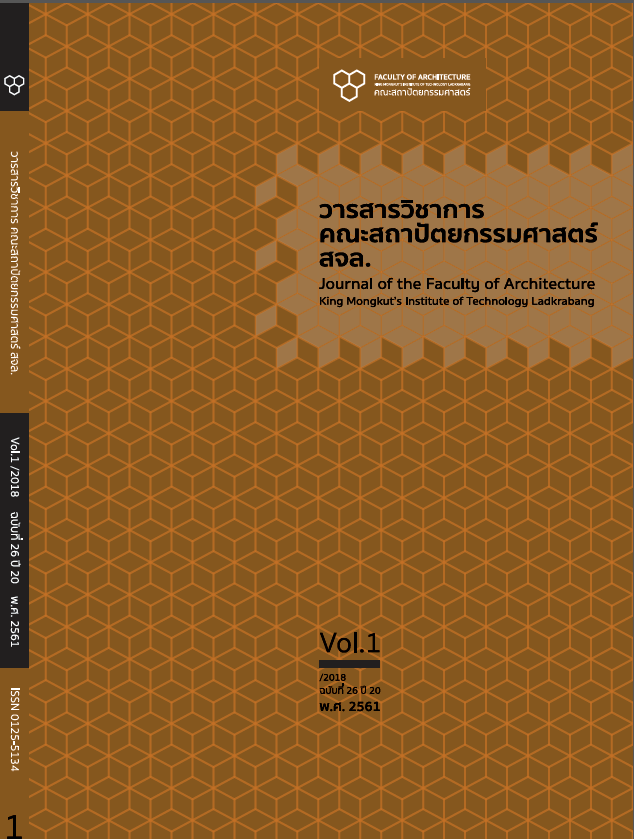การพัฒนาการออกแบบบ้านพักอาศัยสำหรับผู้สูงวัยด้วยหลักการออกแบบสำหรับคนทุกวัย, The Design Development of Elderly Homes by Universal Design Guidelines
Main Article Content
Abstract
Abstract
This study research is resulting from the design development of elderly home by universal design guidelines. Due to the project design of two-story house for family living altogether in various ages, the main
idea of design is to service any function of members of which their behavior and physical needs or activities are also considered. In Thai society, old persons mostly live with the family so there are numbers of them in
different ages. The report is assuming that in 2030, Thailand will be completely aged society. Therefore, this study research is objective to design and develop the project for the elderly people and the universal design,
also to study the materials and the functional equipment in their construction which are purposing for not only old persons but also everybody in the future.
The method of this research results from the users by interviews about their living and thoughts including the survey of site location. In addition, the step of study research is by design, drawing, construction
and collecting the data afterwards. The study research is resulting that the primary consideration of this research is supporting the elderly people to participate the preliminary design which mentally enables them to
be the owners. The common space also encourages their co-operation of activities. If the data collecting is more improved, this can progress the development of housing estate or the house for retirement.
Keywords: Physical Environment Design, House, Elderly People, Universal Design
Article Details
This work is licensed under a Creative Commons Attribution-NonCommercial-ShareAlike 4.0 International License.
Copyright Transfer Statement
The copyright of this article is transferred to Journal of The Faculty of Architecture King Mongkut's Institute of Technology Ladkrabang with effect if and when the article is accepted for publication. The copyright transfer covers the exclusive right to reproduce and distribute the article, including reprints, translations, photographic reproductions, electronic form (offline, online) or any other reproductions of similar nature.
The author warrants that this contribution is original and that he/she has full power to make this grant. The author signs for and accepts responsibility for releasing this material on behalf of any and all co-authors.
References
กรมอนามัย. (2552). คู่มือปฏิบัติงานสำหรับ อสม. เพื่อผู้สูงวัยสายใยรัก ครอบครัว ชุมชน. พิมพ์ครั้งที่ 1. กรุงเทพฯ: สำนักส่งเสริมสุขภาพ กรมอนามัย กระทรวงสาธารณสุข.
จุฬาลงกรณ์มหาวิทยาลัย. (2556). ข้อแนะนำการออกแบบสภาพแวดล้อมและที่พักอาศัยของผู้สูงอายุ. กรุงเทพฯ: หน่วยวิจัยสภาพแวดล้อมที่เหมาะสมกับผู้สูงอายุ ภาควิชาเคหการ คณะสถาปัตยกรรมศาสตร์ จุฬาลงกรณ์มหาวิทยาลัย.
จุฬาลงกรณ์มหาวิทยาลัย. (2558). บ้านปลอดภัย วัยเกษียณ. กรุงเทพฯ: หน่วยวิจัยสภาพแวดล้อมที่เหมาะสมกับผู้สูงอายุภาควิชาเคหการ คณะสถาปัตยกรรมศาสตร์ จุฬาลงกรณ์มหาวิทยาลัย.
ไตรรัตน์ จารุทัศน์. (2560). ทิศทางการพัฒนาที่อยู่อาศัยไทยเพื่อรองรับสังคมสูงวัย. ในงานสัมมนา “ที่อยู่อาศัยสำหรับสังคมผู้สูงอายุ จากมุมมองเชิงนโยบายสู่ภาคปฏิบัติ”. กรุงเทพฯ: ศูนย์ข้อมูลอสังหาริมทรัพย์ ธนาคารอาคารสงเคราะห์
ไตรรัตน์ จารุทัศน์และคณะ. (2548). การศึกษามาตรฐานขั้นตอนสำหรับที่พักอาศัยและสภาพแวดล้อมของผู้สูงอายุ. กรุงเทพฯ.
นวลน้อย บุญวงศ์ และ นัททนี เนียมทรัพย์. (2545). การออกแบบภายในอาคารเพื่อคนพิการ. กรุงเทพฯ: สำนักพิมพ์แห่งจุฬาลงกรณ์มหาวิทยาลัย.
พัชรี ยิ้มรัตนบวร. (23 เมษายน 2559). สัมภาษณ์โดย สุชน ยิ้มรัตนบวร. ติดตามผลกระทบจากการใช้งานบ้านพักอาศัย. บุรีรัมย์.
วิมลสิทธิ์ หรยางกูร. (2541). การจัดทำรายละเอียดโครงการเพื่อการออกแบบงานสถาปัตยกรรม. พิมพ์ครั้งที่ 6.
กรุงเทพฯ: สำนักพิมพ์แห่งจุฬาลงกรณ์มหาวิทยาลัย.
สุชน ยิ้มรัตนบวร. (2560). การศึกษาการพัฒนาการออกแบบบ้านพักอาศัยสำหรับคนทุกวัย. กรุงเทพฯ: มหาวิทยาลัยกรุงเทพ.
สำนักยุทธศาสตร์และการวางแผนพัฒนาทางสังคม (2561).ประชากรสูงอายุ ปี พ.ศ. 2533–2583 รายปี. เข้าถึงได้จาก : http://social.nesdb.go.th/social/Default.aspx?tabid=131.
อัจฉราวรรณ งามญาณ และณัฐวัชร์ เผ่าภู่. (2555). ผู้สูงอายุไทย: การเตรียมการทางด้านการเงิน และลักษณะบ้านพักหลังเกษียณที่ต้องการ. วารสารบริหารธุรกิจ. 35(136), 62-87.

